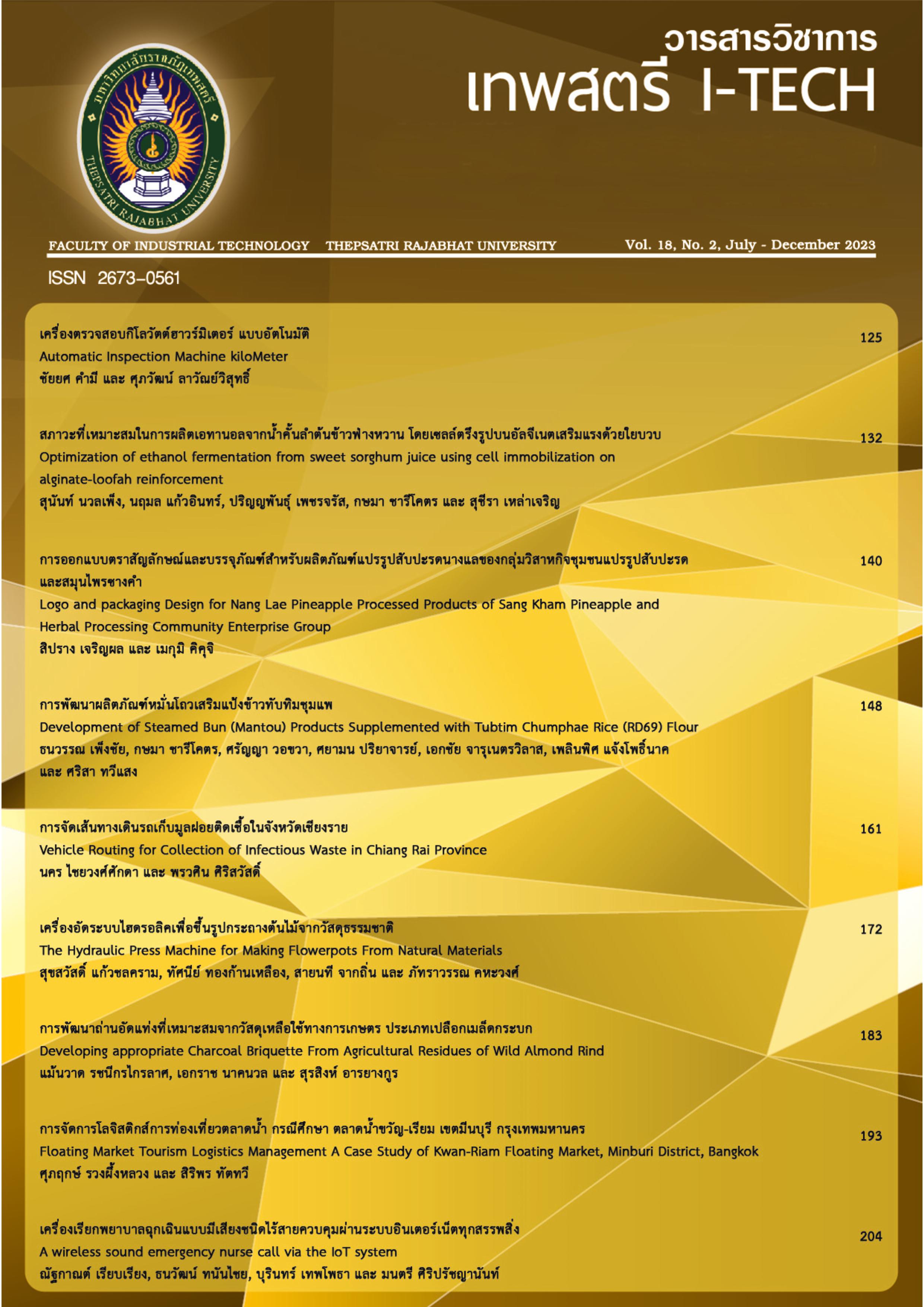การพัฒนาผลิตภัณฑ์หมั่นโถวเสริมแป้งข้าวทับทิมชุมแพ
Abstract
การพัฒนาผลิตภัณฑ์หมั่นโถวเสริมแป้งข้าวทับทิมชุมแพ มีวัตถุประสงค์เพื่อพัฒนาผลิตภัณฑ์หมั่นโถวที่มีคุณค่าทางโภชนาการจากส่วนผสมของแป้งข้าวทับทิมชุมแพและเป็นแนวทางในการพัฒนาผลิตภัณฑ์แปรรูปจากข้าวไทย โดยศึกษาปริมาณการใช้แป้งข้าวทับทิมชุมแพเสริมในผลิตภัณฑ์หมั่นโถวในปริมาณที่เหมาะสม โดยศึกษาปริมาณการเสริมแป้งข้าวทับทิมชุมแพ 0 10 20 และ 30 กรัม พบว่าปริมาณแป้งข้าวทับทิมชุมแพ มีผลต่อเนื้อสัมผัสของผลิตภัณฑ์หมั่นโถว ซึ่งเมื่อมีการเติมปริมาณแป้งข้าวทับทิมชุมแพเพิ่มขึ้น ทำให้หมั่นโถวมีค่าความแข็งเพิ่มขึ้น จากการทดสอบทางด้านประสาทสัมผัสพบว่าผลิตภัณฑ์หมั่นโถวเสริมแป้งข้าวทับทิมชุมแพ 10 กรัม เป็นสูตรผู้บริโภคยอมรับมากที่สุดที่คะแนนความชอบโดยรวมเท่ากับ 7.26 ผลิตภัณฑ์หมั่นโถวมีลักษณะเนื้อสัมผัสนุ่ม มีความยืดหยุ่น สีน้ำตาลอ่อน กลิ่นหอมอ่อนของข้าวทับทิมชุมแพ และมีคุณค่าทางโภชนาการสูง ประกอบด้วย คาร์โบไฮเดรต ไขมัน เกลือแร่ โปรตีน เส้นใย และสารประกอบฟีนอลิกสูง ซึ่งผลิตภัณฑ์หมั่นโถวจากแป้งสาลีเสริมแป้งข้าวทับทิมชุมแพ 10 กรัม มีค่าความชื้น 34.38 % โปรตีน 7.26 % ไขมัน 7.90 % เถ้า 2.59 % ปริมานเส้นใย 0.24 % คาร์โบไฮเดรต 47.63% และปริมาณฟีนอลิกสูงถึง 405.88 mg GAE/100 g ของตัวอย่าง และมีค่าสี L* a* b* เท่ากับ 64.44 5.56 และ 14.75 ตามลำดับ
References
Ministry of Agriculture and Cooperatives. “Thai Agricultural Standards: Thai Colored Rice Standard No. TAS 4006 – 2017”, Office of Standards National agricultural products and food Ministry of Agriculture and Cooperatives. 2017 (in Thai).
Y. Shao, Z. Hu, Y. Yu, R. Mou, Z. Zhu, and T. Beta, “Phenolic acids, anthocyanins, proanthocyanidins, antioxidant activity, minerals and their correlations in non-pigmented, red, and black rice,” Food Chem, vol. 239, pp. 733-741. 2018.
K. Samavardhana, P. Phrigboonchan, T. Supavititpatana, and P. Supavititpatana, “Predicted glycemic index of color rice varieties grown in Thailand,” Khon Kaen Agriculture Journal, suppl, no.1, pp. 124-129. 2022 (in Thai).
R. Changsri, S. Bureerat, T. Prungkong, A. Pengrueng, A. Pongpanus, “RD69 (Tubtim Chumphae), a non-glutinous rice variety,” Thai Rice Research Journal, vol.7, no.2, pp. 30-46. 2016 (in Thai.)
J. Ponglong, L. Senggunprai, P. Tungsutjarit, R. Changsri, T. Proongkhong, S. Thawornchinsombut and P. Pannangpetch, “Hydrolysate and ethanolic extract of Tubtim-Chumphae rice bran improve insulin resistance in high fat-high fructose diet fed rats,” Srinagarind Medical Journal, vol.33, no. 5, 2018.
U. Wattanakul, and W. Wattanakul, “Storage times of stale Tub Tim Chumphae paddy rices to proteins, fats content and bioactive compounds,” Research report. Rajamangala University of Technology Srivijaya, Trang. 57 p. 2019 (in Thai).
S. Chumjit, W. Sangartit, U. Kukongviriyapan, P. Pakdeechote, V. Kukongviriyapan and S. Thawornchinsombat, “Effects of Tubtim Chum Phae rice bran hydrolysates on blood pressure and oxidative stress in L-NAME-induced hypertensive rats,” KKU Research Journal (Graduate Studi25), vol.17, no.3, pp.19-29, 2017.
P. Chutimanukul, C. Jeankham and S. Ngamluan, “Effect of calcium silicate from cement industry on growth, yield, and silicon accumulation of Riceberry and Tubtim Chumphae rice varieties,” Khon Kaen Agriculture Journal, vol.49, no. 3, pp. 577-585, 2021 (in Thai).
S. Chaiyaporn and S. Choenkwan, “Processing of Tubtim Chumphae Rice (RD69) of Ban Khok Sawang Housewives Group Community Enterprise, Wang Yai District, Khon Kaen Province,” Journal of Community Development and Lift Quality, vol.10, no. 2, pp.148-158, May – Aug, 2022 (in Thai).
K. Kongyungyean. Functional Drink product development. National News Bureau of Thailand [Online]. (2021). [Cited May 19, 2023]. Available : https://thainews.prd.go.th/th/news/print_news/TCATG211123165420438
Office of the Royal Society. Mantou and Salapoa. [Online]. (2012). [Cited July 26, 2023]. Available:http://legacy.orst.go.th/?knowledges%
J. Jammek, and O. Naiwikul, Introduction to Bakery Technology. (10th edition), Bangkok: Kasetsart University Press, 2010 (in Thai).
S. Chompuja, “Development of healthy steamed bun (Mantou) products with vegetable Chaya (Tree spinach) juice supplement,” Huachiew Chalermprakiet Science and Technology Journal, vol.6, no. 2, pp. 21-31. 2020 (in Thai).
S. Tipkanon, “Development of mantou product from composite wheat flour and rice flour,” Graduate School, Kasetsart University, Bangkok, 2001 (in Thai).
AOAC International. “Official methods of analysis of AOAC international (2 1st ed.),” The Association of Official Analysis Chemists, 2019.
Y. Shao, F. Xu, X. Sun, J. Bao, and T.Beta, “Identification and quantification of phenolic acids and anthocyanins as antioxidants in bran, embryo and endosperm of white, red and black rice kernels (Oryza sativa L.),” Journal of Cereal Science, vol. 59, pp. 211-218, 2014.
J. Kubola, S. Siriamornpun, and N. Meeso, “Phytochemical, vitamin C and sugar content of Thai fruits,” Food Chemistry, vol. 126, pp. 972- 981, 2011
S. Sinthawalai and K. Janchad, Science and Technology of Baking I Volume 1. Science of Baking. Bangkok: P.L.A., 2001 (in Thai).
P. Kaur, P. Sharma, V. Kumar, A. Panghal, J. Kaur, and Y. Gat, “Effect of addition of flaxseed flour on phytochemical, physicochemical, nutritional, and textural properties of cookies,”Journal of the Saudi Society of Agricultural Sciences, vol.18, pp. 372-377. 2019.
S. Khumkhom, “Effect of Riceberry Flour on Physicochemical Properties and Antioxidant Activities of Steamed Bun,” Thai Science and Technology Journal, vol. 28, no. 11 Nov, 2020 (in Thai).
F. Zhu, and J. Sun, “Physicochemical and sensory properties of steamed bread fortified with purple sweet potato flour,” Food Bioscience, vol.30, Aug, 100411, 2019.
Y. Cao, F. Zhang, P. Guo, S. Dong, and H. Li, “Effect of wheat flour substitution with potato pulp on dough rheology, the quality of steamed bread and in vitro starch digestibility,” LWT Food Sci. Technol, vol.111, pp. 527-533, 2019.
R. Sun, Z. Zhang, X. Hu, Q. Xing, and W. Zhuo, “Effect of wheat germ flour addition on wheat flour, dough, and Chinese steamed bread properties,” Journal of Cereal Science, vol. 64, pp. 153-158, 2015.
R. Preecha, S. Wongpiyachon and N. Kongseree.. “Productdevelopment from wheat-rice composite flour for cake and cookies,” IN Rice and rice products research program, pp.553-607. Kasetsart University., Bangkok, 2000 (in Thai).
S. Khumkhom. “Substitution of wheat flour with Hom Nil rice flour affects physicochemical characteristics, antioxidant activities, and sensory acceptance of Chinese steamed bread (Mantou).” RMUTP Research Journal, vol.14, no.2, Jul-Dec 2020 (in Thai).
S. Lerswanichwatana, P. Chompreeda, V.Haruthaithanasan and K. Sriroth, “Development of curry puff from composite wheat and fragrance rice flour.” In Proceeding of 41th Kasetsart University Annual Conference, Bangkok Thailand, Feb. 3-7, 2003, pp. 323-330 (in Thai).

